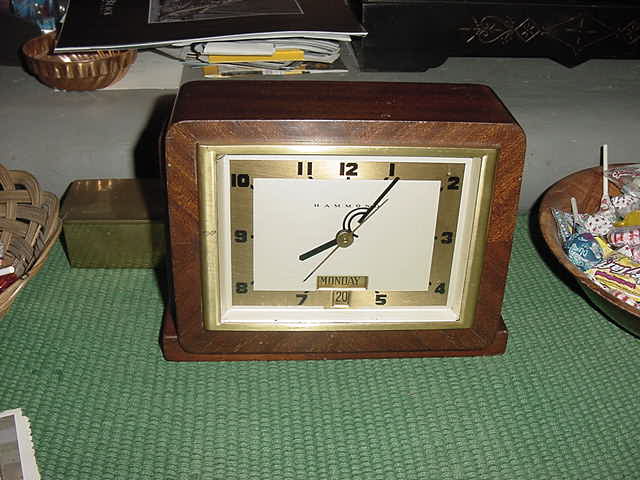
| WWT Shows | CLICK TO: Join and Support Internet Horology Club 185™ | IHC185™ Forums |

|
• Check Out Our... • • TWO Book Offer! • |
Welcome Aboard IHC185™  Internet Horology Club 185
Internet Horology Club 185  IHC185™ Discussion Site Main Page
IHC185™ Discussion Site Main Page  Horological Discussions, Questions and Answers
Horological Discussions, Questions and Answers  Clocks, Including 400-Day Discussions
Clocks, Including 400-Day Discussions  What do I have?
What do I have?
 Internet Horology Club 185
Internet Horology Club 185  IHC185™ Discussion Site Main Page
IHC185™ Discussion Site Main Page  Horological Discussions, Questions and Answers
Horological Discussions, Questions and Answers  Clocks, Including 400-Day Discussions
Clocks, Including 400-Day Discussions  What do I have?
What do I have?Go  | New Topic  | Find-Or-Search  | Notify  | Tools  | Reply to Post  |  |
I am not a clock guy, but will buy one occasionally if I think it is a bargain. This past weekend, I got a clock at a junk store for a meager amount. It is a wooden case table clock. 110V electric. The name on the dial is Hammond. The data plate on the bottom says--Hammond Instrument Company, Chicago. The model # is 319. It also says Hammond Synchronous, and the word Dayton is there. I got the clock in non-running condition and it was filthy dirty. The power cord was completely frayed and deteriorated. I took it apart, cleaned it up, attached a new power cord. Plugged it in, gave the rotor a spin, and it took right off. It is keeping accurate time. As noted on the pic, this has the day/date feature. What do I have here? I'm thinking 1930's for a date. Am I correct. Is this something special with the day/date feature or is this a run of the mill clock. Regardless, it is a nice looking clock in nice condition  | |||
|
Spittler and Bailey's American Clockmakers and Watchmakers indicates that Hammond Instrument Company was active in the 1960s. That clock, however, seems earlier than that. Tom | ||||
|
Hi Tom, Thanks for the info. Being it has the telechron motor with the manual start gave me the idea of the 1930's. Also, the deterioriated power cord, and the broken bakelite plug on it were definitely 1930's vintage. Guess they must have been in business earlier. Anyone else with any info? Tom | ||||
|
The synchronous self-starting electric motor for clocks was invented in 1916 by Henry Warren who started the Warren Clock Co., then the Warren Telechron Company in 1926. General Electric purchased 49% interest in the Warren Telechron Company in 1917. Gradually the GE name appeared on the clocks along with Telechron. In 1946 General Electric took over and in 1979 sold its only remaining clock plant to Timex Corp. This information comes from Jim Linz's Electrifying Time: Telechron & G.E. Clock, 1925-1955. It does mention that Telechron sold movements to The Revere Clock Company (Which was actually Herschede, which was a bit shy to use its good name on this new line of clocks.) I could find no mention of a deal with Hammond, but it is certainly possible. Hammond Clock Co is listed, in the clockmakers book, as in business in 1936. Tom | ||||
|
| IHC President Life Member |
I very fondly remember a Hammond Synchronous Clock from in my boyhood years. My parents were married in 1936 and among the things they acquired that year was a very handsome Hammond Synchronous Clock that was always prominent in our home. As a child I became fascinated with the fact that when there was a power outage the Hammond stopped at that precise time. It had to be re-started by spinning that little knob or as Tom correctly called it the "rotor" found near the time setting on the back. I recall it was possible to run the motor in either direction, and often played a joke of running the clock backwards. If I understand correctly the "Synchronous" name refers to the fact these locked onto the 60 Cycles of Alternating Current and therefore were dead-accurate. Other electric clocks then and now would vary as the voltage would vary, but if the Hammond Synchronous was properly set it reliably indicated the precise time. To accomplish that I always set our clock with the CBS Radio time signal that "beeped" at the top of every hour in the days of network radio. Tom Huber's mention of the frayed cord reminds me of changing the cord on our Hammond clock. The original 1930s cord had cloth wrapping over live rubber. It would have been the late 1950s when I replaced that one with a modern plastic insulated cord for added safety. If Tom's clock had cloth or rubber insulation the 1930s is a fair bet in dating his clock. All that changed during and after the WWII era with rubber and cloth shortages that resulted in newer technologies. As you can see I still find these clocks fascinating and hope this dissertation is of help. | |||
|
Tom and Lindell, Thanks for the further info. Lindell, you are correct in that the accuracy appears to be dead on with my atomic clock. The deteriorated cord, that was left, was only rubber. If it originally had the cloth covering, it was long gone. I'm just glad that there was enough good cord left where it enters the clock so I could attach a new cord. From inspecting the movement and motor, the cord attaches right into the motor coil--no connectors inside the clock. Anyway, I am enjoying it, and it has a place of prominence in my living room. Tom | ||||
|
It is a very handsome clock Tom, I am glad you are enjoying it! Tom | ||||
|
| Powered by Social Strata |
| Your request is being processed... |
|
©2002-2025 Internet Horology Club 185™ - Lindell V. Riddle President - All Rights Reserved Worldwide

